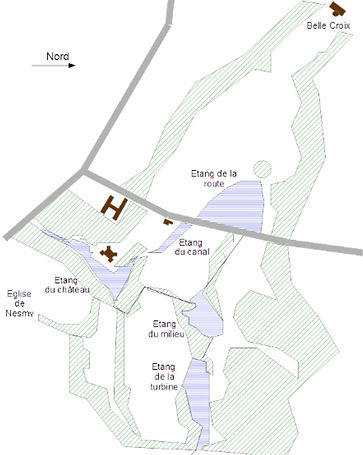
THE CHATEAU DE NESMY PARK
Sight cones, rare species and lakes
The park of the Château de Nesmy has three characteristics:
- English park : it gives a "natural" first impression, but in fact all the views are worked there. Designed by André Leroy in 1842, to replace a more classic park, later improved by the Bülher brothers, the cones of views are improved perspectives that all converge towards the castle. The spaces tighten as one moves away, reinforcing the impression of depth.
- Hydraulic network : it has five ponds which communicate with each other through an ingenious system of overflows and diversion channels. They have a function that is both decorative, through the reflections they allow, defensive, when we remember the old medieval site, and utilitarian, through their fisheries. Nesmy's first electricity was produced by a turbine located downstream from the last pond.
- Botanical park , with many rare species, bald cypresses, redwoods, laricio pines, yews, purple beeches, cryptomerias, Sichuan metasequoia, Virginia tulip trees, cedars of Lebanon, the Himalayas and of the Atlas, honey locusts, weeping pines of the Himalayas, etc. These trees punctuate the perspectives and facilitate escape, as do the constructions of the park in an Italian style, outbuildings, chapel and Belle-Croix farm.
WHAT YOU WILL DISCOVER DURING THE TOUR...
The "secret garden", around the castle pond.
1. In front of the sequoia:
A giant sequoia has been planted next to a well. This type of tree, common in North America, was introduced in France in the second half of the 19th century. Its planting in Nesmy is not surprising, because André Leroy owned a nursery in the United States. The wide variety of tree species planted in the park is visible, as evidenced by :
-
to your left, a Lebanese cedar, a redwood, a liquidambar and an American oak ;
-
on your right, a clump of geraniums and a Virginia tulip tree ;
-
on the other side of the road, bald cypresses, purple beeches and Corsican laricio pines.
2. The castle:
Present since medieval times, its lord having the right of high and low justice, the castle went through the Revolution and the Vendée wars. A Gallic treasure had been found in the castle pond in the 19th century. The castle's current appearance is linked to its "modernization" by Charles and Mathilde de Tinguy in the middle of the 19th century. It was previously a classic Vendée dwelling. In 1842, it was decided to raise the roof, create two round towers (Liberge ) then two square towers and the decoration of the roof (Guillerot).
3. Dependencies
In 1842, the initial outbuildings, on either side of the castle, were destroyed and rebuilt a little further around an open courtyard and a closed courtyard. In order to give a southern atmosphere, the architecture is adapted, the frames of the doors and windows are made of limestone, when the stone of Nesmy is granite.
The windows on the first floor are framed by shutters intended to ensure permanent ventilation. It was a clothes dryer. The outbuildings also include the château's bakery and laundry room.
4. The vegetable garden
The vegetable garden is organized into eight squares distributed around a central path lined with old fruit trees.
5. Around the pond
The walk around the pond allows you to discover masonry banks, as well as a clever system of storm overflows discharging either into the pond of the canal then the road, or into the pond of the turbine. A shovel allowed to drain it to catch fish.
6. The fairground
Hyphen between the castle and the village, a bower connects the field of the fair to the church of Nesmy.
7. The alley of lime trees
The alley of lime trees, which overcomes a medieval roadway, makes it possible to realize that the pond of the castle is in fact higher than a large part of the park. A last look at the castle shows the height of the terrace that supports it.

Overall plan of the park of the castle of Nesmy.
This basic diagram shows two of the characteristics of the Parc du Château de Nesmy: its hydrological network and its cones of view.


